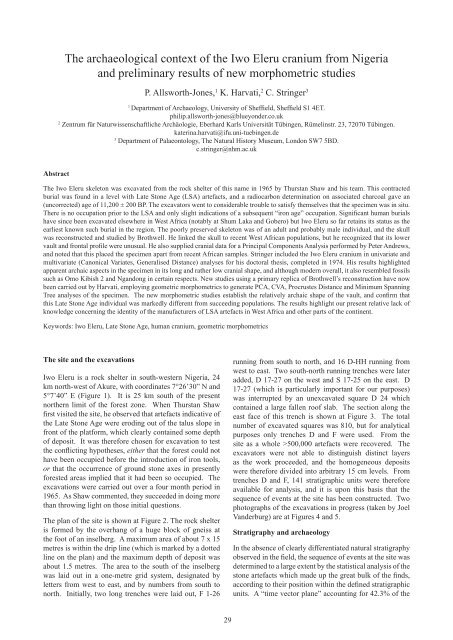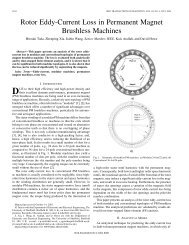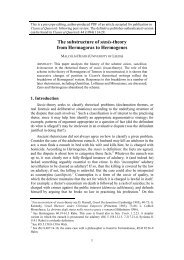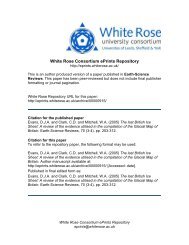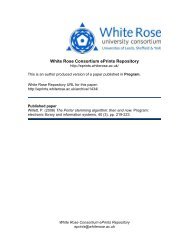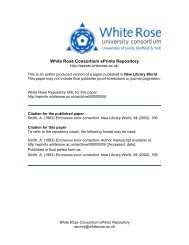The archaeological context of the Iwo Eleru cranium from Nigeria ...
The archaeological context of the Iwo Eleru cranium from Nigeria ...
The archaeological context of the Iwo Eleru cranium from Nigeria ...
You also want an ePaper? Increase the reach of your titles
YUMPU automatically turns print PDFs into web optimized ePapers that Google loves.
Abstract<br />
<strong>The</strong> <strong>archaeological</strong> <strong>context</strong> <strong>of</strong> <strong>the</strong> <strong>Iwo</strong> <strong>Eleru</strong> <strong>cranium</strong> <strong>from</strong> <strong>Nigeria</strong><br />
and preliminary results <strong>of</strong> new morphometric studies<br />
P. Allsworth-Jones, 1 K. Harvati, 2 C. Stringer 3<br />
1 Department <strong>of</strong> Archaeology, University <strong>of</strong> Sheffield, Sheffield S1 4ET.<br />
philip.allsworth-jones@blueyonder.co.uk<br />
2 Zentrum für Naturwissenschaftliche Archäologie, Eberhard Karls Universität Tübingen, Rümelinstr. 23, 72070 Tübingen.<br />
katerina.harvati@ifu.uni-tuebingen.de<br />
3 Department <strong>of</strong> Palaeontology, <strong>The</strong> Natural History Museum, London SW7 5BD.<br />
c.stringer@nhm.ac.uk<br />
<strong>The</strong> <strong>Iwo</strong> <strong>Eleru</strong> skeleton was excavated <strong>from</strong> <strong>the</strong> rock shelter <strong>of</strong> this name in 1965 by Thurstan Shaw and his team. This contracted<br />
burial was found in a level with Late Stone Age (LSA) artefacts, and a radiocarbon determination on associated charcoal gave an<br />
(uncorrected) age <strong>of</strong> 11,200 ± 200 BP. <strong>The</strong> excavators went to considerable trouble to satisfy <strong>the</strong>mselves that <strong>the</strong> specimen was in situ.<br />
<strong>The</strong>re is no occupation prior to <strong>the</strong> LSA and only slight indications <strong>of</strong> a subsequent “iron age” occupation. Significant human burials<br />
have since been excavated elsewhere in West Africa (notably at Shum Laka and Gobero) but <strong>Iwo</strong> <strong>Eleru</strong> so far retains its status as <strong>the</strong><br />
earliest known such burial in <strong>the</strong> region. <strong>The</strong> poorly preserved skeleton was <strong>of</strong> an adult and probably male individual, and <strong>the</strong> skull<br />
was reconstructed and studied by Brothwell. He linked <strong>the</strong> skull to recent West African populations, but he recognized that its lower<br />
vault and frontal pr<strong>of</strong>ile were unusual. He also supplied cranial data for a Principal Components Analysis performed by Peter Andrews,<br />
and noted that this placed <strong>the</strong> specimen apart <strong>from</strong> recent African samples. Stringer included <strong>the</strong> <strong>Iwo</strong> <strong>Eleru</strong> <strong>cranium</strong> in univariate and<br />
multivariate (Canonical Variates, Generalised Distance) analyses for his doctoral <strong>the</strong>sis, completed in 1974. His results highlighted<br />
apparent archaic aspects in <strong>the</strong> specimen in its long and ra<strong>the</strong>r low cranial shape, and although modern overall, it also resembled fossils<br />
such as Omo Kibish 2 and Ngandong in certain respects. New studies using a primary replica <strong>of</strong> Brothwell’s reconstruction have now<br />
been carried out by Harvati, employing geometric morphometrics to generate PCA, CVA, Procrustes Distance and Minimum Spanning<br />
Tree analyses <strong>of</strong> <strong>the</strong> specimen. <strong>The</strong> new morphometric studies establish <strong>the</strong> relatively archaic shape <strong>of</strong> <strong>the</strong> vault, and confirm that<br />
this Late Stone Age individual was markedly different <strong>from</strong> succeeding populations. <strong>The</strong> results highlight our present relative lack <strong>of</strong><br />
knowledge concerning <strong>the</strong> identity <strong>of</strong> <strong>the</strong> manufacturers <strong>of</strong> LSA artefacts in West Africa and o<strong>the</strong>r parts <strong>of</strong> <strong>the</strong> continent.<br />
Keywords: <strong>Iwo</strong> <strong>Eleru</strong>, Late Stone Age, human <strong>cranium</strong>, geometric morphometrics<br />
<strong>The</strong> site and <strong>the</strong> excavations<br />
<strong>Iwo</strong> <strong>Eleru</strong> is a rock shelter in south-western <strong>Nigeria</strong>, 24<br />
km north-west <strong>of</strong> Akure, with coordinates 7°26’30” N and<br />
5°7’40” E (Figure 1). It is 25 km south <strong>of</strong> <strong>the</strong> present<br />
nor<strong>the</strong>rn limit <strong>of</strong> <strong>the</strong> forest zone. When Thurstan Shaw<br />
first visited <strong>the</strong> site, he observed that artefacts indicative <strong>of</strong><br />
<strong>the</strong> Late Stone Age were eroding out <strong>of</strong> <strong>the</strong> talus slope in<br />
front <strong>of</strong> <strong>the</strong> platform, which clearly contained some depth<br />
<strong>of</strong> deposit. It was <strong>the</strong>refore chosen for excavation to test<br />
<strong>the</strong> conflicting hypo<strong>the</strong>ses, ei<strong>the</strong>r that <strong>the</strong> forest could not<br />
have been occupied before <strong>the</strong> introduction <strong>of</strong> iron tools,<br />
or that <strong>the</strong> occurrence <strong>of</strong> ground stone axes in presently<br />
forested areas implied that it had been so occupied. <strong>The</strong><br />
excavations were carried out over a four month period in<br />
1965. As Shaw commented, <strong>the</strong>y succeeded in doing more<br />
than throwing light on those initial questions.<br />
<strong>The</strong> plan <strong>of</strong> <strong>the</strong> site is shown at Figure 2. <strong>The</strong> rock shelter<br />
is formed by <strong>the</strong> overhang <strong>of</strong> a huge block <strong>of</strong> gneiss at<br />
<strong>the</strong> foot <strong>of</strong> an inselberg. A maximum area <strong>of</strong> about 7 x 15<br />
metres is within <strong>the</strong> drip line (which is marked by a dotted<br />
line on <strong>the</strong> plan) and <strong>the</strong> maximum depth <strong>of</strong> deposit was<br />
about 1.5 metres. <strong>The</strong> area to <strong>the</strong> south <strong>of</strong> <strong>the</strong> inselberg<br />
was laid out in a one-metre grid system, designated by<br />
letters <strong>from</strong> west to east, and by numbers <strong>from</strong> south to<br />
north. Initially, two long trenches were laid out, F 1-26<br />
29<br />
running <strong>from</strong> south to north, and 16 D-HH running <strong>from</strong><br />
west to east. Two south-north running trenches were later<br />
added, D 17-27 on <strong>the</strong> west and S 17-25 on <strong>the</strong> east. D<br />
17-27 (which is particularly important for our purposes)<br />
was interrupted by an unexcavated square D 24 which<br />
contained a large fallen ro<strong>of</strong> slab. <strong>The</strong> section along <strong>the</strong><br />
east face <strong>of</strong> this trench is shown at Figure 3. <strong>The</strong> total<br />
number <strong>of</strong> excavated squares was 810, but for analytical<br />
purposes only trenches D and F were used. From <strong>the</strong><br />
site as a whole >500,000 artefacts were recovered. <strong>The</strong><br />
excavators were not able to distinguish distinct layers<br />
as <strong>the</strong> work proceeded, and <strong>the</strong> homogeneous deposits<br />
were <strong>the</strong>refore divided into arbitrary 15 cm levels. From<br />
trenches D and F, 141 stratigraphic units were <strong>the</strong>refore<br />
available for analysis, and it is upon this basis that <strong>the</strong><br />
sequence <strong>of</strong> events at <strong>the</strong> site has been constructed. Two<br />
photographs <strong>of</strong> <strong>the</strong> excavations in progress (taken by Joel<br />
Vanderburg) are at Figures 4 and 5.<br />
Stratigraphy and archaeology<br />
In <strong>the</strong> absence <strong>of</strong> clearly differentiated natural stratigraphy<br />
observed in <strong>the</strong> field, <strong>the</strong> sequence <strong>of</strong> events at <strong>the</strong> site was<br />
determined to a large extent by <strong>the</strong> statistical analysis <strong>of</strong> <strong>the</strong><br />
stone artefacts which made up <strong>the</strong> great bulk <strong>of</strong> <strong>the</strong> finds,<br />
according to <strong>the</strong>ir position within <strong>the</strong> defined stratigraphic<br />
units. A “time vector plane” accounting for 42.3% <strong>of</strong> <strong>the</strong>
West AfricAn ArchAeology: neW developments, neW perspectives<br />
10˚N<br />
5˚N<br />
BENIN<br />
Ibadan<br />
Lagos<br />
Gulf <strong>of</strong><br />
Guinea<br />
5˚E<br />
IWO ELERU<br />
Benin<br />
City<br />
Kaduna<br />
NIGER<br />
Kano<br />
NIGERIA<br />
variance was established for <strong>the</strong> site, and this was divided<br />
into 8 successive groups which are adequately robust<br />
and <strong>the</strong> time directionality <strong>of</strong> which corresponds with<br />
<strong>the</strong> radiocarbon dates and <strong>the</strong> superposition <strong>of</strong> <strong>the</strong> units<br />
within each column at <strong>the</strong> site (Shaw and Daniels, 1984,<br />
Fig. 67). At an early stage <strong>of</strong> <strong>the</strong> work, <strong>the</strong> excavators<br />
noticed that <strong>the</strong>re was a tendency for <strong>the</strong> proportion <strong>of</strong><br />
chalcedony versus quartz to decline with depth, hence<br />
<strong>the</strong> proportions were carefully noted as work proceeded,<br />
and <strong>the</strong> resultant “chalcedony index” was also useful as<br />
a stratigraphic check on <strong>the</strong>ir interpretation. Combining<br />
all <strong>the</strong> information toge<strong>the</strong>r, <strong>the</strong> excavators produced an<br />
“outline <strong>of</strong> <strong>the</strong> <strong>Iwo</strong> <strong>Eleru</strong> succession” (Shaw and Daniels,<br />
1984, Table 17) and this has provided <strong>the</strong> basis for all<br />
fur<strong>the</strong>r characterisation <strong>of</strong> this site and its comparison to<br />
o<strong>the</strong>rs. From our point <strong>of</strong> view, it is important to note that<br />
<strong>the</strong>re was “little accumulation <strong>of</strong> deposit in <strong>the</strong> shelter”<br />
before it began to be used in <strong>the</strong> LSA (Shaw and Daniels,<br />
1984: 6). It was used in <strong>the</strong> recent past by farmers lighting<br />
fires in it, hence its name in Yoruba (“Cave <strong>of</strong> Ashes”).<br />
Some <strong>of</strong> <strong>the</strong> pottery found near <strong>the</strong> surface may also be<br />
recent. <strong>The</strong> bulk <strong>of</strong> it is “iron age” in type and is likely<br />
simply to have become incorporated in <strong>the</strong> LSA deposits,<br />
since no distinctive iron age layer as such was observed.<br />
30<br />
10˚E<br />
0<br />
0<br />
<strong>The</strong> only type <strong>of</strong> pottery definitely attributed to <strong>the</strong> LSA is<br />
comb stamped ware, as clearly found in situ in trench F 9<br />
(Shaw and Daniels, 1984, Plate VIII).<br />
Six samples <strong>of</strong> charcoal were selected for radiocarbon<br />
dating, all <strong>from</strong> trench D, since it was considered that<br />
this showed <strong>the</strong> least evidence <strong>of</strong> disturbance, and it also<br />
contained <strong>the</strong> burial which was located in square D 23.<br />
<strong>The</strong> dates as listed are as follows.<br />
Lab. No. provenance depth below<br />
surface<br />
date BP<br />
Hv 1512 D 21-22 20-35 cm 3465±65<br />
Hv 1510 D 19-20 50-65 cm 5570±60<br />
Hv 1509 D 20 65-80 cm 7030±85<br />
Hv 1511 D 18 95-110 cm 8685±120<br />
I 1754 D 18 100-115 cm 9150±150<br />
I 1753 D 23 around<br />
burial<br />
Lake Chad<br />
100 miles<br />
100 kilometres<br />
Figure 1: Position <strong>of</strong> <strong>Iwo</strong> <strong>Eleru</strong> in South-western <strong>Nigeria</strong>.<br />
CAMEROON<br />
70-100 cm 11200±200<br />
Shaw commented that this is a “consistent block <strong>of</strong> dates<br />
on which considerable reliance can be placed” (Shaw
<strong>the</strong> ArchAeologicAl <strong>context</strong> <strong>of</strong> <strong>the</strong> iWo eleru crAnium <strong>from</strong> nigeriA<br />
Figure 2: <strong>Iwo</strong> <strong>Eleru</strong>: plan <strong>of</strong> <strong>the</strong> site (after Shaw and Daniels 1984, Figure 2).<br />
Figure 3: Section along east face <strong>of</strong> trench D XVII-XXVII (after Shaw and Daniels 1984, Figure 6).<br />
31
West AfricAn ArchAeology: neW developments, neW perspectives<br />
Figure 4: <strong>Iwo</strong> <strong>Eleru</strong>: excavations in progress 1 (courtesy <strong>of</strong> Joel Vanderburg).<br />
Figure 5: <strong>Iwo</strong> <strong>Eleru</strong>: excavations in progress 2 (courtesy <strong>of</strong> Joel Vanderburg).<br />
32
and Daniels, 1984: 7). In <strong>the</strong>ir outline <strong>of</strong> <strong>the</strong> <strong>Iwo</strong> <strong>Eleru</strong><br />
succession, <strong>the</strong> excavators suggested that <strong>the</strong>re were two<br />
basic periods or phases into which <strong>the</strong> sequence could be<br />
divided, A and B, respectively aceramic and ceramic, each<br />
<strong>of</strong> which could be fur<strong>the</strong>r divided into two sub-periods.<br />
<strong>The</strong> four successive divisions could each be associated<br />
with certain <strong>of</strong> <strong>the</strong> “time vector plane” groups and <strong>the</strong><br />
radiocarbon dates, as follows.<br />
period sub-period TVP group radiocarbon date BP<br />
B B2 VI-VII-VIII 3465±65<br />
B1 V 5570±60 and 7030±85<br />
A A2 III-IV 9150±150<br />
A1 I-II 8685±120 and 11200±200<br />
Broadly speaking, it was suggested that <strong>the</strong> chronological<br />
boundaries for <strong>the</strong> periods and sub-periods were<br />
approximately as follows: A1 12,000-9000 BP; A2 9000-<br />
7000 BP; B1 7000-4500 BP; B2 4500-2000 BP.<br />
As stated, a basic criterion for <strong>the</strong> distinction between<br />
periods A and B is <strong>the</strong> appearance <strong>of</strong> pottery in B, certainly<br />
in B2 and probably in B1. Also characteristic <strong>of</strong> B is <strong>the</strong><br />
presence <strong>of</strong> ground stone axes and o<strong>the</strong>r ground stone<br />
artefacts, commonly made <strong>of</strong> very durable materials such<br />
as sillimanite, dolerite, and charnockite. Chalcedony and<br />
quartz was used for <strong>the</strong> chipped stone tool component,<br />
which alone characterised period A. One set <strong>of</strong> tools that<br />
appears in B2 are trapezoids, many with a pronounced<br />
gloss along <strong>the</strong> sharp edge, <strong>the</strong> position <strong>of</strong> which suggests<br />
slightly oblique hafting, possibly for <strong>the</strong> cutting <strong>of</strong> grasses<br />
or cereals such as sorghum (Shaw and Daniels, 1984,<br />
Fig. 38 a and b). Generally however it is noticeable that<br />
microliths (defined quite tightly as small tools with at least<br />
one edge trimmed by steep backing or blunting) decline<br />
in number <strong>from</strong> <strong>the</strong> base <strong>of</strong> <strong>the</strong> sequence upwards. <strong>The</strong>ir<br />
decline is balanced by an increase in <strong>the</strong> number <strong>of</strong> core<br />
tools and o<strong>the</strong>r heavy-duty pieces. This was tentatively<br />
interpreted in environmental terms.<br />
Environmental evidence<br />
Direct environmental evidence at <strong>the</strong> site is slight. Only a<br />
few small badly preserved fragments <strong>of</strong> animal bone were<br />
recovered and no information is available as to what species<br />
may have been represented (Shaw and Daniels, 1984: 30).<br />
Fish otoliths were identified in trench F 21 level 9. 12<br />
species <strong>of</strong> molluscs were recognised by Nora McMillan<br />
(in Shaw and Daniels, 1984: 142-144). Most frequent<br />
was Archachatina marginata, a land snail still commonly<br />
used for food at <strong>the</strong> present time. All <strong>the</strong> o<strong>the</strong>r land snails<br />
could have occurred naturally in <strong>the</strong> surroundings <strong>of</strong><br />
<strong>the</strong> site. Potadoma morchii is a freshwater species, and<br />
its appearance in trench S, where a red clay layer abuts<br />
<strong>the</strong> gneissic block at <strong>the</strong> back <strong>of</strong> <strong>the</strong> site, supports <strong>the</strong><br />
excavators’ conclusion that storm water did accumulate<br />
here <strong>from</strong> time to time. 4 cowries (Cypraea moneta)<br />
occurred near <strong>the</strong> surface. No macrobotanical remains nor<br />
traces <strong>of</strong> pollen were preserved.<br />
<strong>the</strong> ArchAeologicAl <strong>context</strong> <strong>of</strong> <strong>the</strong> iWo eleru crAnium <strong>from</strong> nigeriA<br />
33<br />
<strong>The</strong> environmental history <strong>of</strong> <strong>the</strong> site was <strong>the</strong>refore<br />
interpreted in terms <strong>of</strong> its geographical situation and in<br />
<strong>the</strong> light <strong>of</strong> what was <strong>the</strong>n known about <strong>the</strong> climatic and<br />
vegetational history <strong>of</strong> West Africa in general. Relying<br />
on <strong>the</strong> evidence <strong>from</strong> Lake Chad and Lake Bosumtwi,<br />
among o<strong>the</strong>r places, Shaw assumed that West Africa was<br />
generally dry in <strong>the</strong> late Pleistocene <strong>from</strong> about 18,000<br />
to 10,000 bc; <strong>the</strong> beginning <strong>of</strong> <strong>the</strong> Holocene <strong>from</strong> 10,000<br />
to about 5000 bc represented a climatic optimum; and<br />
<strong>the</strong>reafter <strong>the</strong>re were fluctuations, before <strong>the</strong> present<br />
climatic regime (involving desiccation <strong>of</strong> <strong>the</strong> Sahara) set<br />
in at about 2500 bc. On this assumption, <strong>the</strong> area around<br />
<strong>Iwo</strong> <strong>Eleru</strong> at <strong>the</strong> beginning <strong>of</strong> its occupation will have been<br />
generally dry savanna country. It was assumed that during<br />
<strong>the</strong> late Pleistocene <strong>the</strong> forest will have retreated to small<br />
relict areas along <strong>the</strong> coast, including <strong>the</strong> Niger delta. So<br />
<strong>the</strong> question was, when did <strong>the</strong> forest recover in <strong>the</strong> early<br />
Holocene, so that it embraced <strong>the</strong> <strong>Iwo</strong> <strong>Eleru</strong> area, and what<br />
happened after 5000 bc? Weighing all <strong>the</strong> odds, Shaw<br />
suggested that <strong>the</strong> forest may have advanced quite rapidly,<br />
moving northwards some 200 or 350 km in a few hundred<br />
years. He concluded that <strong>the</strong> forest will have covered<br />
<strong>Iwo</strong> <strong>Eleru</strong> by 5000 bc and that <strong>the</strong>reafter “it remained in<br />
forest until <strong>the</strong> end <strong>of</strong> <strong>the</strong> stone age occupation” (Shaw and<br />
Daniels, 1984: 52).<br />
Some elements <strong>of</strong> <strong>the</strong> <strong>archaeological</strong> succession were<br />
interpreted in that light. It was assumed that microliths<br />
equated with <strong>the</strong> use <strong>of</strong> a bow and arrow in open country,<br />
so <strong>the</strong>ir decline and replacement by heavy-duty equipment<br />
(as known <strong>from</strong> sites in o<strong>the</strong>r forested areas such as Blandè<br />
and Yengema: Shaw, 1978/79, Figs. 4 and 5) would be<br />
quite comprehensible. Shaw inclined to <strong>the</strong> view that <strong>the</strong><br />
advent <strong>of</strong> pottery was due to diffusion <strong>from</strong> <strong>the</strong> north, even<br />
perhaps with <strong>the</strong> “actual movements <strong>of</strong> people southwards”,<br />
since this was <strong>the</strong> time when desiccation commenced in<br />
<strong>the</strong> Sahara (Shaw, 1978/79: 60).<br />
<strong>The</strong> burial<br />
A human burial was found in square D 23, <strong>the</strong> various<br />
parts <strong>of</strong> which were at depths between 82 and 100 cm<br />
<strong>from</strong> <strong>the</strong> surface. A photograph <strong>of</strong> <strong>the</strong> skull as first located<br />
is at Figure 6, and a plan <strong>of</strong> <strong>the</strong> skeletal remains is at<br />
Figure 7. As already mentioned, <strong>the</strong>re is a radiocarbon<br />
date <strong>of</strong> 11,200±200 BP obtained on charcoal found in <strong>the</strong><br />
immediate vicinity <strong>of</strong> <strong>the</strong> burial. <strong>The</strong> skeletal remains<br />
were found in a space between and below two rocks, and a<br />
layer <strong>of</strong> calcareous concretions was observed in <strong>the</strong> same<br />
space, at a higher level, between <strong>the</strong> upper surfaces <strong>of</strong> <strong>the</strong><br />
two rocks. According to Shaw’s description, <strong>the</strong> corpse<br />
<strong>of</strong> this person “had been placed not far <strong>from</strong> bedrock<br />
… and covered with a shallow depth <strong>of</strong> soil early on in<br />
<strong>the</strong> shelter’s use” (Shaw and Daniels, 1984: 4-5). <strong>The</strong><br />
excavators believed that <strong>the</strong> body had probably been buried<br />
in a tightly contracted position. At <strong>the</strong> time, <strong>the</strong>y carefully<br />
considered <strong>the</strong> possibility that <strong>the</strong> burial may have been<br />
intrusive, and <strong>the</strong>y rejected this notion on <strong>the</strong> grounds<br />
that <strong>the</strong>re was no evidence <strong>of</strong> disturbance or <strong>of</strong> a burial<br />
pit. <strong>The</strong> “chalcedony index” did not indicate any anomaly
West AfricAn ArchAeology: neW developments, neW perspectives<br />
Figure 6: <strong>Iwo</strong> <strong>Eleru</strong>, 1965, east face <strong>of</strong> trench D XXII-XXIII. Centimetre scale rests on<br />
skull <strong>of</strong> skeleton. Layer <strong>of</strong> calcareous concretions can be seen extending between <strong>the</strong><br />
upper surfaces <strong>of</strong> <strong>the</strong> two rocks. (after Shaw and Daniels 1984, Plate IX).<br />
Figure 7: <strong>Iwo</strong> <strong>Eleru</strong>: plan <strong>of</strong> human bones in trench D XXIII. Depths indicated<br />
are measured <strong>from</strong> <strong>the</strong> surface after <strong>the</strong> removal <strong>of</strong> <strong>the</strong> superficial layer <strong>of</strong><br />
modern ash. (after Shaw and Daniels 1984, Figure 64).<br />
34
<strong>the</strong> ArchAeologicAl <strong>context</strong> <strong>of</strong> <strong>the</strong> iWo eleru crAnium <strong>from</strong> nigeriA<br />
Figure 8: Late Stone Age sites in West Africa in relation to vegetation zones.<br />
(revised after Shaw 1978-79, Figure 6).<br />
at this point, and <strong>the</strong> layer <strong>of</strong> calcareous concretions<br />
above <strong>the</strong> skeleton did not show any signs <strong>of</strong> disturbance<br />
ei<strong>the</strong>r. <strong>The</strong> excavators believed that <strong>the</strong> human remains<br />
“probably owe <strong>the</strong>ir preservation to a microenvironment<br />
which was exceptionally dry” (Shaw and Daniels, 1984:<br />
29). <strong>The</strong> calcareous nodules were examined by K. Burke<br />
and S.J. Freeth (in Shaw and Daniels, 1984: 136) and <strong>the</strong><br />
conclusion was that <strong>the</strong>y were probably formed as a result<br />
<strong>of</strong> <strong>the</strong> seasonal movement <strong>of</strong> groundwater in this particular<br />
microenvironment. <strong>The</strong> post-cranial remains were found<br />
to be in a state beyond useful reconstruction, but this did<br />
35<br />
not apply to <strong>the</strong> skull, teeth, and mandible (Brothwell and<br />
Shaw, 1971).<br />
Comparisons to o<strong>the</strong>r West African sites<br />
Thurstan Shaw addressed this question in <strong>the</strong> monograph<br />
devoted to <strong>the</strong> site, and also in two general accounts <strong>of</strong><br />
<strong>the</strong> Late Stone Age in West Africa (Shaw and Daniels,<br />
1984; Shaw, 1978/79, 1985). <strong>The</strong> most detailed map was<br />
that published in “Early Man News”, which is reproduced<br />
here (slightly revised) at Figure 8. In <strong>the</strong> general scheme
West AfricAn ArchAeology: neW developments, neW perspectives<br />
put forward, Shaw divided <strong>the</strong> LSA into two successive<br />
phases, aceramic and ceramic, each <strong>of</strong> which was<br />
characterised by a number <strong>of</strong> facies. In <strong>the</strong> aceramic<br />
phase, <strong>the</strong>re were essentially two facies only, microlithic<br />
and non-microlithic (represented on <strong>the</strong> map by open □s<br />
and Δs) and <strong>the</strong>se were equated with savanna and forested<br />
environments respectively. In <strong>the</strong> succeeding phase, <strong>the</strong><br />
same distinction was observed between savanna and forest<br />
(<strong>the</strong> sites being represented on <strong>the</strong> map by filled squares<br />
and triangles). In both, pottery and ground stone axes<br />
made <strong>the</strong>ir appearance, but in <strong>the</strong> savanna <strong>the</strong>se elements<br />
were added to <strong>the</strong> microlithic base whereas in <strong>the</strong> forest<br />
<strong>the</strong>re were still few or no microliths. In <strong>the</strong> former case, as<br />
Shaw put it, pottery and ground stone axes appeared to be<br />
“grafted onto <strong>the</strong> microlithic tradition ra<strong>the</strong>r than to replace<br />
it” (Shaw, 1978/79: 61). Both phases were represented in<br />
superposition at some sites in both environments. In <strong>the</strong><br />
forested south-western part <strong>of</strong> <strong>the</strong> region, mention has<br />
already been made <strong>of</strong> Yengema, and this is shown on <strong>the</strong><br />
map as a numbered pair (9:33), as is Kakimbon (8:32),<br />
whereas Blandè (30) is represented by <strong>the</strong> ceramic phase<br />
only. <strong>The</strong> succession at <strong>Iwo</strong> <strong>Eleru</strong> (3:15) is paralleled<br />
among o<strong>the</strong>r places by that at Dutsen Kongba (38:41),<br />
Rop (2:14), Bosumpra (Abetifi), and o<strong>the</strong>r shelters<br />
along <strong>the</strong> Voltaian scarp (47:48 and 24). Bosumpra was<br />
excavated by Shaw in <strong>the</strong> 1940s and originally published<br />
as a ceramic phase site only, but a pre-ceramic phase was<br />
later detected at this location (Smith 1975). Radiocarbon<br />
dates for <strong>the</strong> transition <strong>from</strong> aceramic to ceramic at Dutsen<br />
Kongba and Bosumpra were not inconsistent with those<br />
<strong>from</strong> <strong>Iwo</strong> <strong>Eleru</strong>. Apart <strong>from</strong> <strong>the</strong> two major ceramic<br />
variants, a number <strong>of</strong> sites in <strong>the</strong> Sahel with few or no<br />
microliths were distinguished as a separate facies, as well<br />
as some coastal shell middens and factory sites (Shaw,<br />
1978/79: 67 Table). Shaw was cautious in not claiming<br />
too much for his scheme, since as he said, it was no more<br />
than a “convenient classification <strong>of</strong> artefact groups with<br />
some reference to ecology”, whereas “its interpretation in<br />
cultural, ethnic and linguistic terms” would require more<br />
research before it could be said to have much reliability<br />
(Shaw, 1978/79: 65). None<strong>the</strong>less, <strong>the</strong> scheme did provide<br />
and still provides a useful framework within which to<br />
consider <strong>the</strong> wider significance <strong>of</strong> <strong>Iwo</strong> <strong>Eleru</strong>.<br />
Human skeletal material was mentioned <strong>from</strong><br />
Karkarichinkat, Kourounkorokale, Tichitt, Daima,<br />
Kintampo, and Rop (Shaw, 1978/79: 76) but at <strong>the</strong> time<br />
none <strong>of</strong> this material was dated and was certainly not<br />
considered older than <strong>Iwo</strong> <strong>Eleru</strong>.<br />
Recent developments<br />
Since <strong>the</strong> original report on <strong>Iwo</strong> <strong>Eleru</strong> was published, at<br />
least two hi<strong>the</strong>rto unknown sites with skeletal remains<br />
have been located in <strong>the</strong> region, new information has been<br />
obtained about <strong>the</strong> chronology <strong>of</strong> <strong>the</strong> MSA and <strong>the</strong> LSA in<br />
general, and considerable attention has also been devoted<br />
to <strong>the</strong> study <strong>of</strong> <strong>the</strong> environment during <strong>the</strong> period in<br />
question. <strong>The</strong>se developments will briefly be summarised<br />
ins<strong>of</strong>ar as <strong>the</strong>y are relevant to <strong>Iwo</strong> <strong>Eleru</strong>.<br />
36<br />
Shum Laka and Gobero<br />
<strong>The</strong>se are key sites, nei<strong>the</strong>r <strong>of</strong> which was known when<br />
Shaw published his work on <strong>Iwo</strong> <strong>Eleru</strong>.<br />
Shum Laka is a rock shelter 15 km south-west <strong>of</strong> Bamenda<br />
in western Cameroun (5°51’37” N, 10°04’44” E). At<br />
an altitude <strong>of</strong> 1650 metres above sea level, it is situated<br />
in <strong>the</strong> mountainous region known as <strong>the</strong> Grasslands.<br />
Following initial investigations, an extensive excavation<br />
was undertaken over a six month period in 1991-1994, and<br />
this has provided <strong>the</strong> essential information about <strong>the</strong> site<br />
(Lavachery et al., 1996; Moeyersons, 1997; Lavachery,<br />
2001; Cornelissen, 2003). It has been demonstrated, for<br />
<strong>the</strong> first time in West Africa, that <strong>the</strong> LSA extends back<br />
into <strong>the</strong> Pleistocene. Five radiocarbon dates (<strong>from</strong> layer S)<br />
span <strong>the</strong> period <strong>from</strong> 31,700±750 to 12,800±110 BP. As at<br />
<strong>Iwo</strong> <strong>Eleru</strong>, <strong>the</strong> sequence continues into <strong>the</strong> early Holocene<br />
and beyond (layer A, divided into a lower ochre and an<br />
upper grey coloured unit), extending without much sign<br />
<strong>of</strong> interruption into <strong>the</strong> early iron age. <strong>The</strong> microlithic<br />
industry, made principally in quartz, is very similar to<br />
that <strong>from</strong> <strong>Iwo</strong> <strong>Eleru</strong>, although macrolithic elements which<br />
appear in <strong>the</strong> upper part <strong>of</strong> <strong>the</strong> sequence are distinctive.<br />
Cornelissen and Lavachery question whe<strong>the</strong>r (as in Shaw’s<br />
scheme) microliths should necessarily be considered an<br />
adaptation to savanna conditions, and <strong>the</strong> macrolithic<br />
“culture” characterised by “waisted axes” which appears<br />
later seems to be bounded by frontiers which do not<br />
reflect ecological conditions. As at <strong>Iwo</strong> <strong>Eleru</strong> however<br />
an aceramic phase is succeeded by a ceramic phase, with<br />
<strong>the</strong> earliest pottery in <strong>the</strong> ochre layer A dated to 7140±50<br />
BP. As a result <strong>of</strong> <strong>the</strong>se discoveries, it has been suggested<br />
by MacDonald (1997: 161, 192) that we should think in<br />
terms <strong>of</strong> “a new model for <strong>the</strong> peopling <strong>of</strong> West Africa<br />
based upon a long-term autochthonous presence south <strong>of</strong><br />
<strong>the</strong> Sahara”, which found its material expression in “an<br />
indigenous terminal Pleistocene West African microlithic<br />
techno-complex”.<br />
18 skeletons have been found in <strong>the</strong> Holocene deposits at<br />
<strong>the</strong> site, in 9 burial complexes, which are attributed to two<br />
different chronological phases (Orban et al., 1996; Ribot<br />
et al., 2001). 3 burials with 4 individuals are attributed to<br />
<strong>the</strong> ochre layer A, with dates in <strong>the</strong> range <strong>from</strong> 7150±70 to<br />
6870±80 BP. This layer corresponds <strong>archaeological</strong>ly and<br />
chronologically to period B1 at <strong>Iwo</strong> <strong>Eleru</strong>, and <strong>the</strong> burials<br />
are clearly more recent than <strong>the</strong> one at <strong>Iwo</strong> <strong>Eleru</strong>. Orban<br />
and Ribot and <strong>the</strong>ir colleagues compared <strong>the</strong>se skeletons to<br />
<strong>Iwo</strong> <strong>Eleru</strong> principally on <strong>the</strong> basis <strong>of</strong> postcranial features,<br />
particularly estimated stature (Ribot et al., 2001: table<br />
35), though similarities were also detected in terms <strong>of</strong> a<br />
broad mandibular ramus and very worn teeth (Ribot et al.,<br />
2001: 193). Two adult male burials at Shum Laka have<br />
an estimated stature in <strong>the</strong> range 161-166 cm, compared<br />
with a figure for <strong>Iwo</strong> <strong>Eleru</strong> <strong>of</strong> 158-166 cm. 6 burials are<br />
known <strong>from</strong> <strong>the</strong> grey layer A, which has dates between<br />
3300±90 and 2940±60 BP. Of <strong>the</strong> individuals identified<br />
9 are children and 5 are adults. Chronologically <strong>the</strong> finds<br />
correspond to period B2 at <strong>Iwo</strong> <strong>Eleru</strong>. <strong>The</strong>re are marked
distinctions between this population and <strong>the</strong> preceding one,<br />
so much so that <strong>the</strong>y are considered to be “biologically<br />
different” (Ribot et al., 2001: 192). Two adult female<br />
individuals at Shum Laka, SE III and SE IV, have an<br />
estimated stature <strong>of</strong> 153-155 and 143-148 cm respectively;<br />
this, it is considered, suggests “an affinity with Pygmy<br />
populations”, although <strong>the</strong>re is no supporting evidence to<br />
confirm this hypo<strong>the</strong>sis (Ribot et al., 2001: 176).<br />
Gobero is a site complex in central Niger, which was<br />
discovered in 2000 and excavated in 2005-2006; not<br />
surprisingly, it has attracted a good deal <strong>of</strong> attention<br />
(Sereno et al., 2008; Gwin, 2008). It is located on <strong>the</strong><br />
north-western rim <strong>of</strong> <strong>the</strong> Chad basin, about 150 km sou<strong>the</strong>ast<br />
<strong>of</strong> <strong>the</strong> Aïr massif. At <strong>the</strong> beginning <strong>of</strong> <strong>the</strong> Holocene a<br />
shallow freshwater lake formed here, pooled against a low<br />
east-west fault scarp, and, with an interruption, this lake<br />
continued in existence for some 5000 years. Both lake<br />
episodes were associated with human occupation, traces<br />
<strong>of</strong> which are now preserved in three main palaeodune<br />
deposits (Sereno et al., 2008, Fig. 1). A minimum <strong>of</strong> 182<br />
human burials have been noted, <strong>of</strong> which 67 have been<br />
excavated. 78 radiocarbon dates have been obtained<br />
and 9 OSL dates on palaeodune sand. On this basis, <strong>the</strong><br />
excavators have divided <strong>the</strong> sequence into four principal<br />
phases (Sereno et al., 2008, Fig. 3). Phase 2 represents<br />
<strong>the</strong> early Holocene occupation, which has been dated in<br />
<strong>the</strong> range <strong>from</strong> 8640±40 to 7390±40 BP. <strong>The</strong> artefacts<br />
(including bone harpoons and ceramics) are characteristic<br />
<strong>of</strong> <strong>the</strong> Kiffian techno-complex. <strong>The</strong> analysis conducted<br />
by Sereno and his colleagues suggests that <strong>the</strong> population<br />
represented here is similar to <strong>the</strong> “Mechtoids” described<br />
<strong>from</strong> North Africa and <strong>the</strong> Sahara. Phase 3 is assigned to<br />
<strong>the</strong> mid-Holocene and has dates in <strong>the</strong> range <strong>from</strong> 5940±40<br />
to 4090±40 BP. <strong>The</strong> artefacts (including hollow-based<br />
projectile points and pottery) belong to <strong>the</strong> Tenerean technocomplex.<br />
No particular affinities have been suggested for<br />
this “morphologically isolated” human group (Sereno et<br />
al., 2008, Fig. 6), but it is considered unlikely that <strong>the</strong>y<br />
evolved in situ <strong>from</strong> <strong>the</strong> preceding population.<br />
<strong>The</strong>se studies clearly show that <strong>the</strong> population <strong>of</strong> this area<br />
in <strong>the</strong> early and mid Holocene was not homogeneous. But<br />
so far, <strong>Iwo</strong> <strong>Eleru</strong> retains its status as <strong>the</strong> earliest known<br />
excavated burial in <strong>the</strong> region.<br />
<strong>The</strong> wider <strong>context</strong><br />
So far, <strong>the</strong>re is no o<strong>the</strong>r Pleistocene LSA succession<br />
in West Africa comparable to Shum Laka. As already<br />
remarked, pottery came into use at that site at about <strong>the</strong><br />
same time as at <strong>Iwo</strong> <strong>Eleru</strong>. At Ounjougou, in Mali, <strong>the</strong>re<br />
is a radiocarbon date <strong>of</strong> 8700±75 BP directly associated<br />
with pottery at Ravin du Hibou (Huysecom et al., 2004a,<br />
2004b; Raeli and Huysecom, 2004). <strong>The</strong> assemblage here<br />
is described as Kiffian, and in terms <strong>of</strong> dating this obviously<br />
is consonant with <strong>the</strong> evidence <strong>from</strong> Gobero. In 2007 a<br />
few more sherds were found in a stratigraphically lower<br />
horizon at Ravin de la Mouche, so <strong>the</strong> advent <strong>of</strong> pottery at<br />
this site may be even earlier (Huysecom et al., 2009, Fig. 1<br />
and Table 1). As a whole <strong>the</strong>refore <strong>the</strong> evidence still seems<br />
<strong>the</strong> ArchAeologicAl <strong>context</strong> <strong>of</strong> <strong>the</strong> iWo eleru crAnium <strong>from</strong> nigeriA<br />
37<br />
to support Shaw’s view that <strong>the</strong> advent <strong>of</strong> pottery in West<br />
Africa was due to diffusion <strong>from</strong> <strong>the</strong> north. Ounjougou is<br />
important for an entirely different reason, since, as reported<br />
at this conference by Sylvain Soriano (see also Rasse et al.,<br />
2004), it has produced for <strong>the</strong> first time a reliably dated<br />
West African Pleistocene sequence for <strong>the</strong> MSA, dated by<br />
OSL to a period <strong>from</strong> about 160 to 19 kyrs BP. <strong>The</strong>re<br />
are also two OSL dates <strong>of</strong> 40.8±11.4 and 23.6±9 kyrs BP<br />
<strong>from</strong> Birimi in nor<strong>the</strong>rn Ghana for a “flake industry with<br />
a strong Levallois component” (Casey, 2003; Quickert et<br />
al., 2003). <strong>The</strong>re are still no hominid associations with <strong>the</strong><br />
MSA in West Africa, but if <strong>the</strong> younger <strong>of</strong> <strong>the</strong> dates at <strong>the</strong>se<br />
two sites are correct <strong>the</strong>n <strong>the</strong> makers <strong>of</strong> <strong>the</strong>se industries<br />
(whoever <strong>the</strong>y were) will have lived (presumably) side by<br />
side with <strong>the</strong> makers <strong>of</strong> <strong>the</strong> LSA.<br />
<strong>The</strong> main characteristics and <strong>the</strong> chronology <strong>of</strong> <strong>the</strong> late<br />
Pleistocene and <strong>the</strong> early Holocene in West Africa and<br />
<strong>the</strong> Sahara have been clearly delineated in recent studies,<br />
which broadly speaking do confirm <strong>the</strong> model which<br />
Shaw employed at <strong>the</strong> time <strong>the</strong> <strong>Iwo</strong> <strong>Eleru</strong> report was<br />
written. DeMenocal and his colleagues have established<br />
a framework for <strong>the</strong> nature and longevity <strong>of</strong> <strong>the</strong> African<br />
Humid Period, which followed <strong>the</strong> end <strong>of</strong> <strong>the</strong> Pleistocene,<br />
on <strong>the</strong> basis <strong>of</strong> <strong>the</strong> marine core at ODP site 658C <strong>of</strong>f Cap<br />
Blanc, Mauritania (DeMenocal et al., 2000, Figs. 2, 3, and<br />
4). Humid conditions initially commenced at about 14.8<br />
cal kyrs BP, with <strong>the</strong> main episode <strong>of</strong> <strong>the</strong> AHP occurring<br />
between about 9 and 5.5 cal kyrs BP. It is likely that during<br />
<strong>the</strong> Late Glacial Maximum <strong>the</strong> sou<strong>the</strong>rn boundary <strong>of</strong> <strong>the</strong><br />
Sahara may have been situated at about 14°N, whereas<br />
in <strong>the</strong> early Holocene <strong>the</strong> nor<strong>the</strong>rn boundary <strong>of</strong> <strong>the</strong> forest<br />
may have reached as far as 10-12°N (Dupont et al., 2000).<br />
Lézine and Cazet (2005, Fig. 5) have proposed a stepwise<br />
model for <strong>the</strong> northward expansion <strong>of</strong> <strong>the</strong> forest in<br />
West Africa during <strong>the</strong> AHP, extending <strong>from</strong> about 11.6<br />
to 9.3 cal kyrs BP. <strong>The</strong>re was a similarly uneven retreat at<br />
<strong>the</strong> end <strong>of</strong> <strong>the</strong> period. <strong>The</strong>re is some disagreement about<br />
<strong>the</strong> extent to which <strong>the</strong> forest was reduced to fragments<br />
along <strong>the</strong> coast during <strong>the</strong> LGM, but <strong>the</strong> principle <strong>of</strong> its<br />
expansion is not in doubt. Any discrepancy between <strong>the</strong>se<br />
authors is unlikely to upset Thurstan Shaw’s idea that <strong>the</strong><br />
occupation <strong>of</strong> <strong>Iwo</strong> <strong>Eleru</strong> began in savanna conditions and<br />
persisted in a forested environment. <strong>The</strong> advance <strong>of</strong> <strong>the</strong><br />
forest in <strong>the</strong> AHP was mirrored by a rise in lake levels,<br />
most notably Lake Chad (Leblanc et al., 2006). <strong>The</strong> lake<br />
may have begun to fill as far back as 10,160±160 BP and<br />
may not finally have begun to retreat until 3000±110<br />
BP. It is estimated that it will have been at its maximum<br />
extent between about 7700 and 5500 BP, corresponding to<br />
about 8.5 to 6.3 cal kyrs BP. Lake Mega Chad <strong>the</strong>refore<br />
constitutes one <strong>of</strong> <strong>the</strong> most dramatic evidences for an early<br />
Holocene climatic optimum and its eventual decline to<br />
conditions more resembling those <strong>of</strong> <strong>the</strong> present.<br />
Studies <strong>of</strong> <strong>the</strong> <strong>Iwo</strong> <strong>Eleru</strong> <strong>cranium</strong><br />
<strong>The</strong> poorly preserved skeleton was <strong>of</strong> an adult and<br />
probably male individual, and <strong>the</strong> skull was reconstructed<br />
and studied by Brothwell (Brothwell and Shaw, 1971). He
West AfricAn ArchAeology: neW developments, neW perspectives<br />
Figure 9; <strong>Iwo</strong> <strong>Eleru</strong> <strong>cranium</strong>:<br />
left lateral view.<br />
Figure 10: <strong>Iwo</strong> <strong>Eleru</strong> mandible:<br />
left lateral view.<br />
Classic<br />
Neanderthal<br />
Steinheim<br />
Solo<br />
Amud<br />
Krapina C<br />
Saccopastore<br />
Swanscombe<br />
Broken Hill<br />
Pekin Petralona<br />
Cohuna<br />
38<br />
linked <strong>the</strong> skull to recent West African populations, but<br />
he recognized that its lower vault and frontal pr<strong>of</strong>ile were<br />
unusual, and <strong>the</strong> mandible was robust (Figures 9 and 10).<br />
He also supplied cranial data for a Principal Components<br />
Analysis performed by Peter Andrews, and noted that this<br />
placed <strong>the</strong> specimen apart <strong>from</strong> recent African samples.<br />
Stringer included measurements <strong>of</strong> <strong>the</strong> original <strong>Iwo</strong><br />
<strong>Eleru</strong> <strong>cranium</strong> in univariate and multivariate (Canonical<br />
Variates, Generalised Distance) analyses for his doctoral<br />
<strong>the</strong>sis, completed in 1974 (Stringer 1974a). Coefficients<br />
<strong>of</strong> separate determination in a cranial analysis using 17 <strong>of</strong><br />
Howells’ measures showed that <strong>the</strong> main discriminators<br />
<strong>from</strong> <strong>the</strong> Upper Palaeolithics were low frontal subtense,<br />
low vertex radius, high cranial breadth, high bifrontal<br />
breadth, high cranial length and low parietal subtense,<br />
against Neanderthals <strong>the</strong>y were primarily low supraorbital<br />
projection, low frontal fraction, high parietal chord, high<br />
frontal chord, low frontal subtense and low vertex radius,<br />
while against Zhoukoudian Homo erectus <strong>the</strong>y were low<br />
supraorbital projection, high parietal chord, high bifrontal<br />
breadth, high vertex radius, high frontal chord and low<br />
frontal subtense.<br />
Overall it appeared that <strong>the</strong> <strong>cranium</strong> was “modern” in its<br />
low supraorbital projection, and long frontal and parietal<br />
chords, but “archaic” in its high cranial length, low vertex<br />
radius, and low frontal and parietal subtenses. Stringer’s<br />
results highlighted apparent archaic aspects in <strong>the</strong> specimen<br />
in its long and ra<strong>the</strong>r low cranial shape, and although<br />
modern overall, it also resembled fossils such as Omo<br />
Kibish 2 and Ngandong in several respects, falling closer<br />
to <strong>the</strong>m than to Upper Palaeolithic and recent samples<br />
in some analyses (Figure11: after summary diagram in<br />
Stringer 1974b).<br />
Djebel Irhoud Skhul 5<br />
Omo 2<br />
Upper Palaeolithic<br />
Figure 11: Comparative analysis <strong>of</strong> <strong>Iwo</strong> <strong>Eleru</strong> <strong>cranium</strong> (after Stringer 1974b).<br />
Omo 1<br />
<strong>Iwo</strong> <strong>Eleru</strong>
<strong>the</strong> ArchAeologicAl <strong>context</strong> <strong>of</strong> <strong>the</strong> iWo eleru crAnium <strong>from</strong> nigeriA<br />
Figure 12 a and b. Coordinates <strong>of</strong> neurocranial osteometric landmarks.<br />
A new geometric morphometric study <strong>of</strong> <strong>the</strong> cranial configurations in specimen space (Rohlf and Marcus,<br />
vault<br />
Figure 12 1993; b O’Higgins, 2000; Harvati, 2003a,b; Harvati et al.,<br />
2007). Geometric morphometrics also readily account for<br />
Recently a primary replica <strong>of</strong> <strong>the</strong> cranial vault <strong>of</strong> <strong>the</strong> size correction and provide a way <strong>of</strong> quantifying shape<br />
<strong>Iwo</strong> <strong>Eleru</strong> specimen, produced before its return to variability <strong>of</strong> traits which are difficult to measure with<br />
<strong>Nigeria</strong>, was digitized by Harvati and included in a 3-D conventional measurements and are <strong>the</strong>refore usually<br />
geometric morphometric multivariate statistical analysis. described qualitatively (Harvati, 2003a; Nicholson and<br />
Comparisons <strong>of</strong> Stringer’s measurements on <strong>the</strong> original Harvati, 2006, Gunz and Harvati, 2007). <strong>The</strong> geometric<br />
and <strong>the</strong> replica show a maximum discrepancy <strong>of</strong> 1 mm, morphometric study <strong>of</strong> <strong>the</strong> <strong>Iwo</strong> <strong>Eleru</strong> specimen included<br />
suggesting that <strong>the</strong> replica accurately reflects <strong>the</strong> original curve (semilandmark) as well as landmark data. Thus <strong>the</strong><br />
shape <strong>of</strong> <strong>the</strong> <strong>cranium</strong>. <strong>The</strong> goal <strong>of</strong> this study was to analysis quantifies not only overall cranial shape, which<br />
evaluate <strong>the</strong> cranial shape and size <strong>of</strong> this specimen in is also reflected by traditional measurements, but also <strong>the</strong><br />
<strong>the</strong> <strong>context</strong> <strong>of</strong> Middle and Late Pleistocene and Holocene detailed shape <strong>of</strong> particular anatomical regions, such as <strong>the</strong><br />
human morphological variation in order to fur<strong>the</strong>r assess supraorbital morphology.<br />
its affinities and phylogenetic/population relationships.<br />
Data were collected in <strong>the</strong> form <strong>of</strong> three-dimensional<br />
Geometric morphometric approaches are complementary coordinates <strong>of</strong> neurocranial osteometric landmarks, defined<br />
to and expand on traditional multivariate analyses based as homologous points that can be reliably and repeatedly<br />
on linear and angular measurements, such as those located, using a Microscribe (Immersion Corp., 1998)<br />
conducted by Stringer. <strong>The</strong>se coordinate-based methods portable digitizer. Landmarks along <strong>the</strong> midsagittal pr<strong>of</strong>ile<br />
better preserve <strong>the</strong> geometry <strong>of</strong> <strong>the</strong> objects studied <strong>from</strong> glabella to inion, along <strong>the</strong> coronal and lambdoid<br />
and allow intuitive visualization <strong>of</strong> shape differences sutures, and along <strong>the</strong> upper margin <strong>of</strong> <strong>the</strong> supraorbital<br />
between ei<strong>the</strong>r individual specimens or group mean shape torus were also registered (Figure 12). <strong>The</strong> points along<br />
39<br />
a<br />
Figure 12 a<br />
b
Figure 13<br />
West AfricAn ArchAeology: neW developments, neW perspectives<br />
Figure 13: Position <strong>of</strong> <strong>Iwo</strong> <strong>Eleru</strong> <strong>cranium</strong> as determined by Harvati (present study).<br />
<strong>the</strong>se outlines were automatically resampled to yield <strong>the</strong><br />
same semilandmark count on every specimen (Bookstein,<br />
1997; see also Gunz and Harvati, 2007). <strong>The</strong>se points were<br />
chosen so as to reflect <strong>the</strong> neurocranial morphology <strong>of</strong> <strong>the</strong><br />
<strong>Iwo</strong> <strong>Eleru</strong> specimen as fully as possible. Semilandmarks<br />
were ‘slid’ in Ma<strong>the</strong>matica (Wolfram Research, Inc., 2007)<br />
using routines developed by Philipp Gunz and Philipp<br />
Mitteroecker (see also Gunz and Harvati, 2007; Harvati<br />
et al., 2007). Finally, landmarks and slid semilandmarks<br />
were superimposed with Generalized Procrustes Analysis<br />
(GPA) using <strong>the</strong> Morpheus s<strong>of</strong>tware package (Slice,<br />
1998). <strong>The</strong> superimposed coordinates were <strong>the</strong>n analyzed<br />
statistically using principal components analysis (PCA),<br />
canonical variates analysis, Procrustes distances, and<br />
Mahalanobis squared distances. <strong>The</strong>se statistics were<br />
calculated with <strong>the</strong> s<strong>of</strong>tware packages SAS (SAS Institute,<br />
1999-2001), NTSys (Applied Biostatistics Inc., 1986-<br />
2000), and TPSsmall (version 1.20; Rohlf, 2003).<br />
<strong>The</strong> comparative sample for this analysis comprised<br />
forty-seven Pleistocene adult human fossils <strong>from</strong> Africa<br />
and Eurasia, including specimens attributed to Homo<br />
heidelbergensis, Neanderthals, early anatomically modern<br />
humans and Upper Paleolithic modern humans. It also<br />
included two hundred and forty two recent human crania<br />
representing nine broad geographic groups, including<br />
Africans.<br />
<strong>The</strong> preliminary results <strong>of</strong> this reanalysis (Figure 13) largely<br />
concur with <strong>the</strong> findings <strong>of</strong> Stringer (1974a). <strong>Iwo</strong> <strong>Eleru</strong>,<br />
40<br />
while overall modern, appears to retain important archaic<br />
elements in its morphology that align it with specimens <strong>of</strong><br />
early modern and late archaic humans. <strong>The</strong>se retentions<br />
are evident both in <strong>the</strong> results <strong>of</strong> <strong>the</strong> statistical analysis as<br />
well as in <strong>the</strong> visualization <strong>of</strong> <strong>Iwo</strong> <strong>Eleru</strong>’s cranial shape in<br />
comparison with <strong>the</strong> mean shapes <strong>of</strong> <strong>the</strong> various groups<br />
included in <strong>the</strong> analysis. A complete description <strong>of</strong> <strong>the</strong><br />
3-D analysis and its findings is currently being prepared<br />
for publication.<br />
Acknowledgements<br />
<strong>The</strong> authors would like to thank Pr<strong>of</strong>essor Thurstan<br />
Shaw and Steve Daniels for <strong>the</strong>ir readiness to discuss <strong>the</strong><br />
findings <strong>from</strong> <strong>Iwo</strong> <strong>Eleru</strong>, and also Joel Vanderburg and<br />
Doig Simmonds for <strong>the</strong>ir recollections <strong>of</strong> <strong>the</strong> dig and <strong>the</strong>ir<br />
provision <strong>of</strong> illustrative material.<br />
References<br />
Applied Biostatistics Inc. 1986-2000. NTSYSpc, Version<br />
2.10t. Applied Biostatistics Inc.<br />
Bookstein, F.L. 1997. Landmark methods for forms without<br />
landmarks: Morphometrics <strong>of</strong> group differences in<br />
outline shape. Medical Image Analysis, 1(3): 225-243.<br />
Brothwell, D., T. Shaw. 1971. A Late Upper Pleistocene<br />
Proto-West African Negro <strong>from</strong> <strong>Nigeria</strong>. Man, (new<br />
series), 6 (2): 221-227.<br />
Casey, J. 2003. <strong>The</strong> Archaeology <strong>of</strong> West Africa <strong>from</strong> <strong>the</strong><br />
Pleistocene to <strong>the</strong> Mid-Holocene. In ed. J. Mercader,
Under <strong>the</strong> Canopy: <strong>The</strong> Archaeology <strong>of</strong> Tropical Rain<br />
Forests, 35-63. Rutgers University Press, New Jersey.<br />
Cornelissen, E. 2003. On Microlithic Quartz Industries<br />
at <strong>the</strong> End <strong>of</strong> <strong>the</strong> Pleistocene in Central Africa: <strong>The</strong><br />
Evidence From Shum Laka (NW Cameroon). African<br />
Archaeological Review, 20(1): 1-24.<br />
DeMenocal, P., J. Ortiz, T. Guilderson, J. Adkins, M.<br />
Sarn<strong>the</strong>in, L. Baker, M. Yarusinsky. 2000. Abrupt<br />
onset and termination <strong>of</strong> <strong>the</strong> African Humid Period:<br />
rapid climate responses to gradual insolation forcing.<br />
Quaternary Science Reviews, 19: 347-361.<br />
Dupont, L.M., S. Jahns, F. Marret, S. Ning. 2000. Vegetation<br />
change in equatorial West Africa: time-slices for <strong>the</strong><br />
last 150 ka. Palaeogeography, Palaeoclimatology,<br />
Palaeoecology, 155: 95-122.<br />
Gunz, P., K. Harvati. 2007. <strong>The</strong> Neanderthal “chignon”:<br />
Variation, integration and homology. Journal <strong>of</strong> Human<br />
Evolution, 52: 262-274.<br />
Gwin, P. 2008. Lost Tribes <strong>of</strong> <strong>the</strong> Green Sahara. National<br />
Geographic, 214(3): 126-143.<br />
Harvati, K. 2003a. Quantitative analysis <strong>of</strong> Neanderthal<br />
temporal bone morphology using 3-D geometric<br />
morphometrics. American Journal <strong>of</strong> Physical<br />
Anthropology, 120: 323-338.<br />
Harvati K. 2003b. <strong>The</strong> Neanderthal taxonomic position:<br />
models <strong>of</strong> intra- and inter-specific morphological<br />
variation. Journal <strong>of</strong> Human Evolution, 44:107-132.<br />
Harvati, K., P. Gunz, D. Grigorescu. 2007. Cioclovina<br />
(Romania): Morphological affinities <strong>of</strong> an early modern<br />
European. Journal <strong>of</strong> Human Evolution, 53: 732-746.<br />
Huysecom, E., A. Mayor, S. Ozainne, M. Rasse, K. Schaer,<br />
S. Soriano. 2004a. Ounjougou: plus de 100,000 ans<br />
d’histoire en pays dogon (Mali). Archäologie der<br />
Schweiz, 27(3): 2-13.<br />
Huysecom, E., S. Ozainne, F. Raeli, A. Ballouche, M.<br />
Rasse, S. Stokes. 2004b. Ounjougou (Mali): A history<br />
<strong>of</strong> Holocene settlement at <strong>the</strong> sou<strong>the</strong>rn edge <strong>of</strong> <strong>the</strong><br />
Sahara. Antiquity, 78 (301): 579-593.<br />
Huysecom, E., M. Rasse, L. Lespez, K. Neumann, A.<br />
Fahmy, A. Ballouche, S. Ozainne, M. Maggetti, Ch.<br />
Tribolo, S. Soriano. 2009. <strong>The</strong> emergence <strong>of</strong> pottery<br />
in Africa during <strong>the</strong> tenth millennium cal BC: new<br />
evidence <strong>from</strong> Ounjougou (Mali). Antiquity, 83: 905-<br />
917.<br />
Immersion Corp. 1998. Microscribe 3D User’s Guide.<br />
Immersion Corporation, San Jose, CA.<br />
Lavachery, P. 2001. <strong>The</strong> Holocene Archaeological<br />
Sequence <strong>of</strong> Shum Laka Rock Shelter (Grassfields,<br />
Western Cameroon). African Archaeological Review,<br />
18(4): 213-247.<br />
Lavachery, P., E. Cornelissen, J. Moeyersons, P. de Maret.<br />
1996. 30,000 ans d’occupation, 6 mois de fouilles:<br />
Shum Laka, un site exceptionnel en Afrique centrale.<br />
Anthropologie et Préhistoire, 107: 197-211.<br />
Leblanc, M., G. Favreau, J. Maley, Y. Nazoumou, C.<br />
Leduc, F. Stagnitti, P.J. van Oevelen, F. Delclaux, J.<br />
Lemoalle. 2006. Reconstruction <strong>of</strong> Megalake Chad<br />
using Shuttle Radar Topographic Mission data. 2006.<br />
Palaeogeography, Palaeoclimatology, Palaeoecology,<br />
<strong>the</strong> ArchAeologicAl <strong>context</strong> <strong>of</strong> <strong>the</strong> iWo eleru crAnium <strong>from</strong> nigeriA<br />
41<br />
239: 16-27.<br />
Lézine, A-M., J-P. Cazet. 2005. High-resolution pollen<br />
record <strong>from</strong> core KW31, Gulf <strong>of</strong> Guinea, documents<br />
<strong>the</strong> history <strong>of</strong> <strong>the</strong> lowland forests <strong>of</strong> West Equatorial<br />
Africa since 40,000 yr ago. Quaternary Research, 64:<br />
432-443.<br />
MacDonald, K.C. 1997. Korounkorokalė Revisited:<br />
<strong>The</strong> Pays Mande and <strong>the</strong> West African Microlithic<br />
Technocomplex. African Archaeological Review, 14:<br />
161-200.<br />
Moeyersons, J. 1997. Geomorphological processes<br />
and <strong>the</strong>ir palaeoenvironmental significance at <strong>the</strong><br />
Shum Laka cave (Bamenda, western Cameroon).<br />
Palaeogeography, Palaeoclimatology, Palaeoecology,<br />
133: 103-116.<br />
Nicholson E. and Harvati K. 2006. Quantitative Analysis<br />
<strong>of</strong> Human Mandibular Shape Using 3-D Geometric<br />
Morphometrics. American Journal <strong>of</strong> Physical<br />
Anthropology, 131:368-383.<br />
O’Higgins, P. 2000. <strong>The</strong> study <strong>of</strong> morphological variation<br />
in <strong>the</strong> hominid fossil record: Biology, landmarks and<br />
geometry. Journal <strong>of</strong> Anatomy, 197: 103-120.<br />
Orban, R., I. Ribot, S. Fenaux, P. de Maret. 1996. Les<br />
restes humains de Shum Laka (Cameroun, LSA – Âge<br />
du Fer). Anthropologie et Préhistoire, 107: 213-225.<br />
Quickert, N.A., D.I. Godfrey-Smith, J.L. Casey. 2003.<br />
Optical and <strong>the</strong>rmo-luminescence dating <strong>of</strong> Middle<br />
Stone Age and Kintampo bearing sediments at Birimi,<br />
a multi-component <strong>archaeological</strong> site in Ghana.<br />
Quaternary Science Reviews, 22: 1291-1297.<br />
Rasse, M., S. Soriano, C. Tribolo, S. Stokes, E. Huysecom.<br />
2004. La séquence Pléistocène Supérieur d’Ounjougou<br />
(Pays Dogon, Mali, Afrique de l’Ouest): Évolution<br />
géomorphologique, enregistrements sédimentaires, et<br />
changements culturels. Quaternaire, 15(4): 329-341.<br />
Raeli, F., E. Huysecom. 2001. Nouvelles hypothèses sur le<br />
peuplement de l’Afrique de l’Ouest au 8ème millénaire<br />
av. J.-C.: Apport du gisement d’Ounjougou (Mali). In:<br />
ed. Y. Droz, A. Mayor, L. Roost Vischer, C. Thévoz,<br />
Partenariats Nord-Sud Forschungs-partnerschaften,<br />
Werkschau Afrikastudien 3, LIT Verlag, Münster: 305-<br />
321.<br />
Ribot, I., R. Orban, P. de Maret. 2001. <strong>The</strong> prehistoric<br />
burials <strong>of</strong> Shum Laka rockshelter (North-West<br />
Cameroun). Musée Royal de l’Afrique Centrale,<br />
Tervuren, Belgique: Annales, Sciences Humaines: vol.<br />
164.<br />
Rohlf, F.J. 2003. tpsSmall v. 1.20. Department <strong>of</strong> Ecology<br />
and Evolution, State University <strong>of</strong> New York, Stony<br />
Brook, New York.<br />
Rohlf, F.J., L. F. Marcus. 1993. A revolution in<br />
morphometrics. Trends in Ecology and Evolution, 8:<br />
129-132.<br />
SAS Institute. 1999-2001. SAS System for Windows V8.<br />
<strong>The</strong> SAS Institute.<br />
Sereno, P.C., E.A.A. Garcea, H. Jousse, C.M. Stojanowski,<br />
J.M. Saliège, A. Maga, O.A. Ide, K.J. Knudson, A.M.<br />
Mercuri, T.W. Stafford, T.G. Kaye, C. Giraudi, I.M.<br />
N’siala, E. Cocca, H.M. Moots, D.B. Du<strong>the</strong>ll, J.P.
West AfricAn ArchAeology: neW developments, neW perspectives<br />
Stivers. 2008. Lakeside Cemeteries in <strong>the</strong> Sahara:<br />
5000 Years <strong>of</strong> Holocene Population and Environmental<br />
Change. PLoS ONE 3(8): e2995. doi: 10.1371/journal.<br />
pone.0002995.<br />
Shaw, T. 1978/79. Holocene Adaptations in West Africa:<br />
<strong>The</strong> Late Stone Age. Early Man News, 3/4, Tübingen:<br />
51-82.<br />
Shaw, T. 1985. <strong>The</strong> prehistory <strong>of</strong> West Africa. In ed.<br />
J.F. Ade Ajayi and M. Crowder, History <strong>of</strong> West Africa,<br />
vol. 1, 3rd ed., Longmans: 48-86.<br />
Shaw, T., S.G.H. Daniels. 1984. Excavations at <strong>Iwo</strong><br />
<strong>Eleru</strong>, Ondo State, <strong>Nigeria</strong>. West African Journal <strong>of</strong><br />
Archaeology, volume 14.<br />
42<br />
Slice, D.E. 1998. Morpheus et al.: s<strong>of</strong>tware for morphometric<br />
research. Revision 01-30-98. Department <strong>of</strong> Ecology<br />
and Evolution, State University <strong>of</strong> New York, Stony<br />
Brook, New York.<br />
Stringer, C. B. 1974a. A multivariate study <strong>of</strong> cranial<br />
variation in Middle and Upper Pleistocene human<br />
populations. Ph.D. <strong>the</strong>sis, University <strong>of</strong> Bristol<br />
Stringer, C.B. 1974b. Population relationships <strong>of</strong> later<br />
Pleistocene hominids: a multivariate study <strong>of</strong> available<br />
crania. Journal <strong>of</strong> Archaeological Science 1: 317-342.<br />
Wolfram Research, Inc. 2007. Ma<strong>the</strong>matica Edition,<br />
Version 6.0. Wolfram Research, Inc., Champaign,<br />
Illinois.


